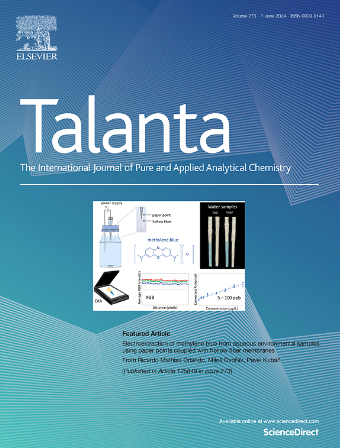Low-background CRISPR/Cas12a sensing system with circular CRISPR RNA for amplified fluorescent detection of antibody in human serum
IF 5.6
1区 化学
Q1 CHEMISTRY, ANALYTICAL
引用次数: 0
Abstract
Regular monitoring of serum antibody levels is crucial for preventing interference with therapeutic effectiveness and reducing the risk of toxicity. To address this, a CRISPR/Cas12a sensing system with circular CRISPR RNAs (CcrRNAs) is described for highly sensitive detection of anti-digoxin (Anti-Dig) antibodies in human serum. In this work, the topology structure of CcrRNAs effectively suppresses the function of linear crRNAs (LcrRNAs), making them unable to regulate the cis-/trans-cleavage activity of the Cas12a system. Therefore, a low-background is obtained in the absence of targets. The target Anti-Dig antibodies trigger the assembly of the complete multicomponent nucleic acid enzyme (MNAzyme) with active enzyme activity, which can transform CcrRNAs into LcrRNAs. The LcrRNAs further recover the trans-cleavage activity of the CRISPR/Cas12a system, which can degrade single-stranded reporter DNA to generate a significantly enhanced fluorescent signal. This method enables sensitive detection of Anti-Dig antibodies as low as 15 pM within 60 min and exhibits a linear detection range of 25 pM–50 nM. It also exhibits excellent selectivity against non-target antibodies and has been successfully validated in diluted serum samples, achieving a recovery rate ranging from 96.16 % to 103.08 %. This novel CRISPR/Cas12a sensing system with CcrRNA represents a powerful and efficient tool for detecting low-abundance biomarkers in complex biological samples.

求助全文
约1分钟内获得全文
求助全文
来源期刊

Talanta
化学-分析化学
CiteScore
12.30
自引率
4.90%
发文量
861
审稿时长
29 days
期刊介绍:
Talanta provides a forum for the publication of original research papers, short communications, and critical reviews in all branches of pure and applied analytical chemistry. Papers are evaluated based on established guidelines, including the fundamental nature of the study, scientific novelty, substantial improvement or advantage over existing technology or methods, and demonstrated analytical applicability. Original research papers on fundamental studies, and on novel sensor and instrumentation developments, are encouraged. Novel or improved applications in areas such as clinical and biological chemistry, environmental analysis, geochemistry, materials science and engineering, and analytical platforms for omics development are welcome.
Analytical performance of methods should be determined, including interference and matrix effects, and methods should be validated by comparison with a standard method, or analysis of a certified reference material. Simple spiking recoveries may not be sufficient. The developed method should especially comprise information on selectivity, sensitivity, detection limits, accuracy, and reliability. However, applying official validation or robustness studies to a routine method or technique does not necessarily constitute novelty. Proper statistical treatment of the data should be provided. Relevant literature should be cited, including related publications by the authors, and authors should discuss how their proposed methodology compares with previously reported methods.
 求助内容:
求助内容: 应助结果提醒方式:
应助结果提醒方式:


